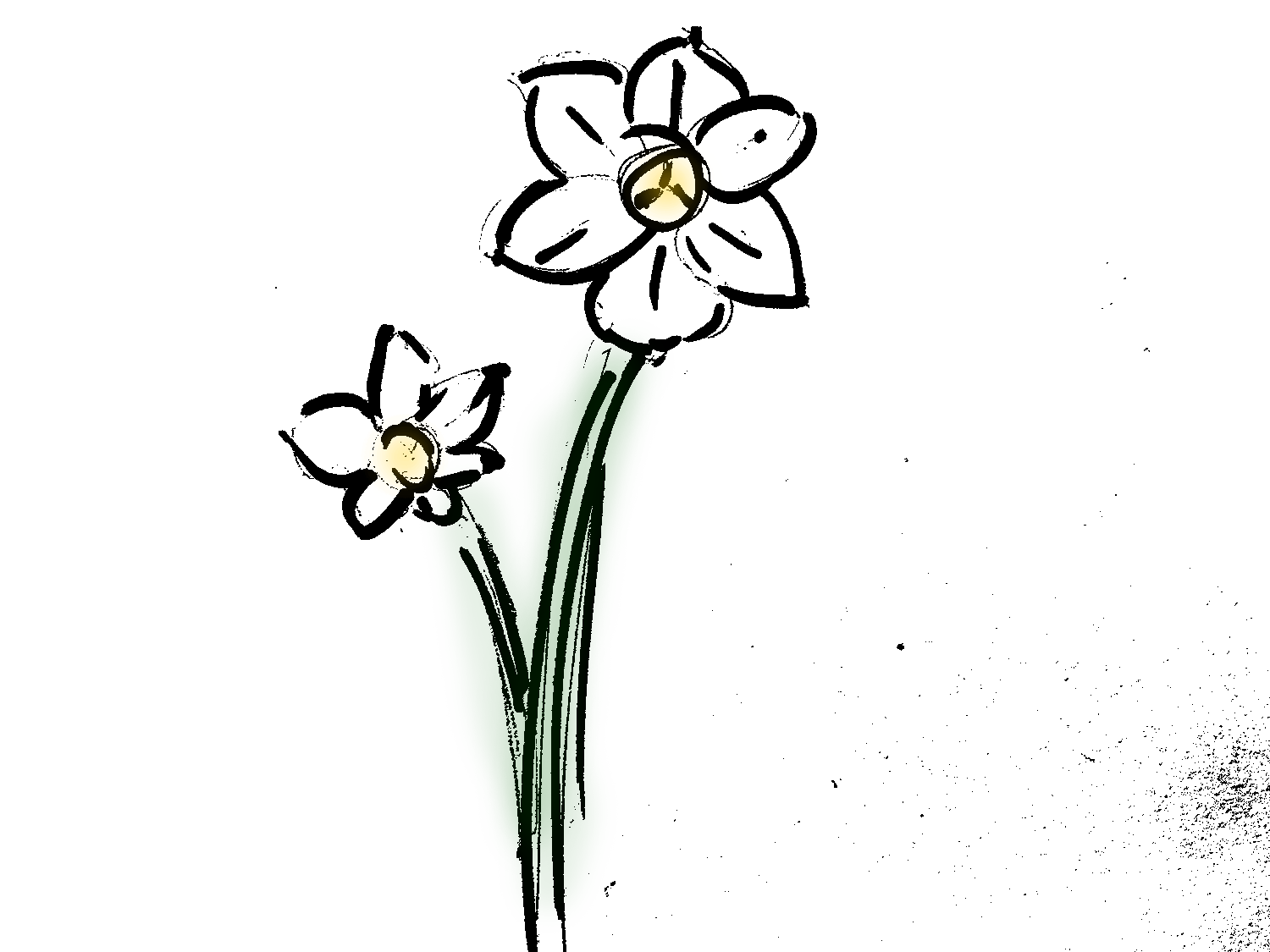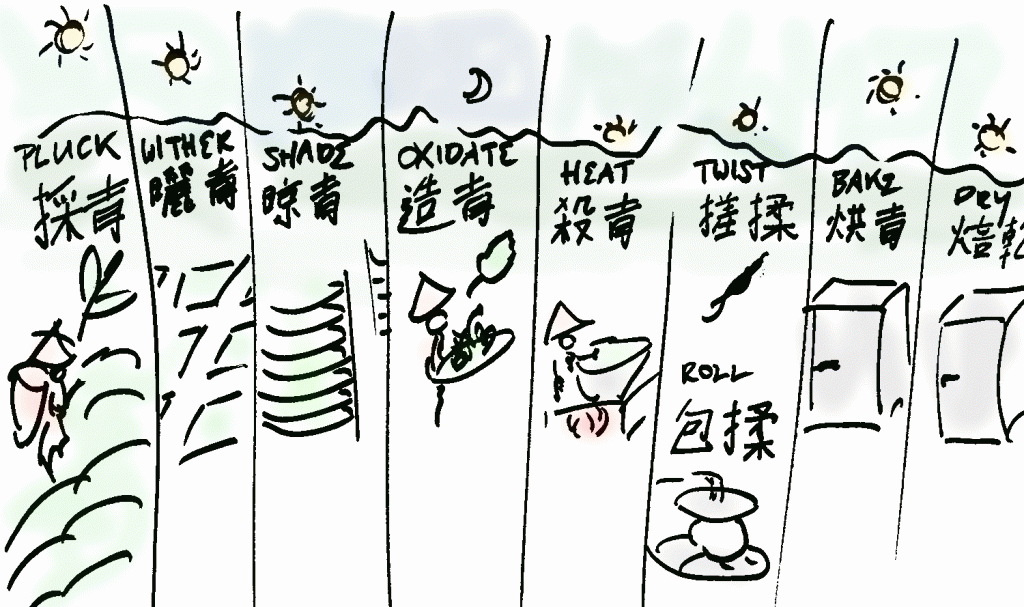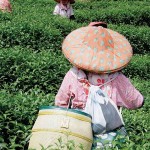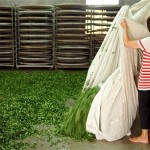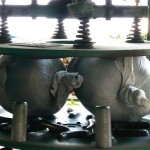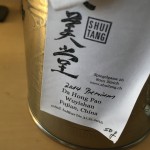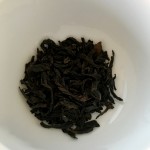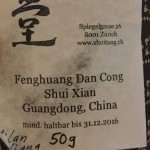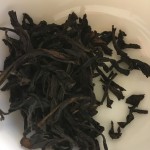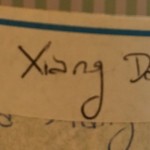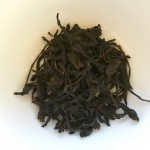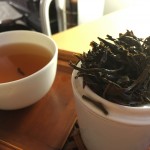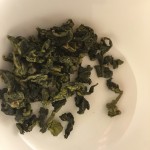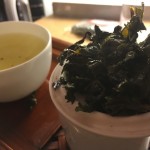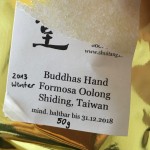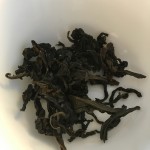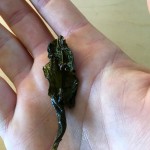I’m lucky that I could learn a great deal about tea from Meng-Lin Chou. She is possibly one of the most knowledgeable people in Europe when it comes to oolong teas. Visit her store in Zurich, and check out her blog!
Oolong (烏龍茶) means black dragon, and is a category of partially oxidised teas. It is possibly the most diverse category, with aromas ranging from the flowery to the fruity to the leathery. It is also a very exciting category these days, with lots of innovation stemming from the exchange between China and Taiwan.
Oolong Production
According to Tea Guardian, the production of this tea has 8 distinct stages, which have to occur in immediate succession, taking about 2 days.
- Plucking. The production is quite stressful for the leaves, so the leaves must be big and robust so they can endure the treatment. Because of this, harvest occurs on a sunny day just before or after midday, so the leaves are fully expanded, free of dew and have the most sap. The leaves that are picked are the open ones; so the buds and young leaves are not picked to keep the tree healthy. This is very different from green teas, for example, where soft and young leaves are favoured, and harvest occurs in the morning.
- Withering in the sun. The leaves are laid out in the sun for 2-3h as soon as possible after plucking. If too much time passes and the leaves start to wilt in the plucker’s basket, the resulting tea will taste muddy.
- Shading. After this they are brought in to cool and rehydrate.
- Oxidation. By now it will be around 5 o’clock in the after noon. The leaves are rattled for 5m every 2h or so, so that the edges rub against each other and the cell wall breaks. This causes the enzymes to leak out onto the leaves and react with the other constituents of the tea. It can be seen by a reddening of the rim of the leaves. These days, this process is usually carried out automatically in drum rolls, but some tea makers still perform this step by hand. A more recent development is to perform this step in a cooled environment, which brings out more flowery, fresh aromas.
- Killing the greens. Around breakfast time the tea maker will decide when it is time to stop the oxidation and heat the leaves to arrest the enzymatic oxidation. Heating can happen in the wok or oven, and is sometimes still carried out by hand.
- Curling, twisting or rolling. The leaves are twisted or rolled for bring the essential oils to the surface and to give the tea its distinct shape. Again, this process can be done by machines or by hand.
- Baking. The tea is baked at around 100°C for 5-10m four times, with some hours rest in between. Sometimes this is done over charcoal, giving a special aroma to the tea. However, if this process is not done correctly, it can cause the return of the green, that is, the tea will start to develop some grassy aromas with some months of storage. This is the result of some enzymes in the core of the tea leaves becoming active again, and is undesirable.
- Drying. After sorting out twigs, the tea will then baked again to become fully dry so it can be stored. Some tea makers will rest the tea for a few months and then bake it again.
The images in the above gallery are kindly provided by Shui Tang.
Nomenclature
Oolongs are categorised by region of origin, cultivar, and special modifiers such as dancong and guifei.
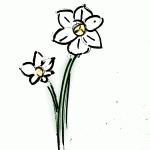
Cultivars. The main cultivars used are Shuixian (水仙, Water Lily) and Wulong, but there are many more. Shuixian is the name of the Chinese Sacred Lily, which has a cleansing aroma. Teas from this cultivar will have a similar aroma. Other famous cultivars are Da Hong Pao (Big Red Robe), Tie Lohan (Iron Buddhist Monk), and Tie Guan Yin (Iron Goddess of Mercy). More common cultivars include Rougui and Mei Zhan. Teas made from the Rougui cultivar usually have a strong cinnamon and mint aroma.
Regions. There are four main regions that produce oolong:
- Phoenix oolongs from Fenghuang (鳳凰) mountains in Guangdong. They are usually extremely flowery in taste.
- Wuyi (武夷山) mountains in norther-west Fujian. They are a UNESCO world heritage site. There are a plethora of old wild trees here, so that this region is a bit like a genetic storeroom. They are famous for Yan Cha (岩茶) – rock tea – because their teas grow on the mountains. They tend to have shorter, but more strong, robust aroma; dry and mineralic. Traditionally fired at high temperatures.
- Anxi (安溪) in southern Fujian, also called Minnan. These teas are usually rolled to pearls.
- Taiwan. Within Taiwan, the famous oolong regions are Nantou, Dongding, and Alishan mountains. Taiwan also helped popularise the high mountain (gao shan) oolongs.
Dancong (單欉) means single bush. This means that the tea comes from a single tree, and many varieties will carry names such as Mi Lan (honey-orchid) that will describe their taste. It is a very common practise in Guangdong, so that almost all oolongs from that region will be Dancong. However, Dancong has almost become synonymous with Guangdong teas, so sometimes you can find teas labeled as Dancong even though they are a blend from different trees.
Guifei, Dongfang Meiren (東方美人) or Oriental Beauty, is quite peculiar: Jassid cicadas sometimes nibble on the oolong leaves while they are still on the tree and suck out their juices. This causes the plant to produce special chemicals, and cause the enzymatic oxidation to occur while the leaves are still growing. From this stems a sought-after honey-muscatel aroma. This is not unlike the noble rot in Sauternes wines. However, the cicadas cannot be counted on, so such teas can be quite rare. They prefer wild, organic gardens though with lots of plant variety – such gardens, however, are more difficult to maintain.
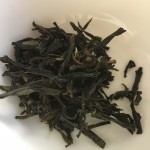
Xue Pian (China) or Dong Pian (Taiwan) is a modifier for special harvests: During winter warm winds can trick the tea plants into thinking it’s spring and cause them to sprout. At the same time, the nights still get frosty. Through this the tea develops a very special elegant, sweeter aroma leaning towards vanilla.
Aroma
Common aromas among oolongs are honey, flowery (especially osmanthus and lily), mineral and fruity (peach and plum).
Besides from the intensity of the roasting at the end of the production, the degree of oxidation has the biggest impact on the aroma of the tea: Lightly oxidised oolongs will have flowery, green tastes, while longer oxidised teas will taste fruitier. Oolong teas used to be heavily oxidised and thoroughly baked, but the trend these days is towards lighter, greener tastes.
Famous Oolongs
Da Hong Pao (大紅袍, Big Red Robe) from Wuyi. Legend has it that an Ming dynasty emperor’s mother was cured from a sickness drinking this tea, and the emperor thus send red robes to cover the trees. There are still 3 or 4 trees that are supposedly from Song dynasty (960-1279), which still produce this tea. Most tea, however, is farmed from genetically identical cuttings. Very intense tea, good expression of a Wuyi Yan Cha, big nose of orange, leather and a bit of muscatel; the taste is similar, with some sandalwood, dried apricots and a good chalk minerality joining in. Very strong and pungent, good astringency, little sweetness.
Feng Huang Dan Cong Shui Xian (鳳凰單欉) from Guangdong. This tea is made from wild plants that grow in the forest, moderate oxidation. Dancongs can be very flowery, like blossoms, depending on the cultivar, orchids or lily. These teas are then usually baked quite lightly, to promote their floral aromas. This Shui Xian has a good taste of the lily of the valley, then in the back some old forest leaves, vanilla, rasin and caramel.
Milan Xiang Dan Cong (蜜蘭香單欉), means honey-orchid scent. Alot more orchid, lighter, no minerality, slim astringency. Unlike other Dancongs, this one focuses more on more classical oolong aromas like honey and baked sweet potatos.
Tie Guan Yin (鐵觀音, Iron Goddess of Mercy) from Anxi. This is the name of a specific cultivar, which is quite difficult to keep happy. Nowadays produced with low oxidation, sometimes called bouquet style: The leaves are oxidised for a long time at temperatures below 20°C, which makes it very calm, light and quite flowery (jasmin, magnolia, orchid). There are still some more traditional styles with more thorough oxidation and firing; these are more intense, in taste, and have warmer aromas with a sweet aftertaste.
Green style Tie Guan Yin
Dong Ding from Nantou. Dong Ding is the name of the mountain in Nantou where this tea is made, but also the name of a cultivar, which originally came from Wuyi. There are teas by the name of Dong Ding, however, which are not from the Dong Ding cultivar. The tea grows in 1400m above sea, and benefits from the mineralic soil, which gives it a distinct clay taste. Depending on how its produced, aromas from leather and tobacco, but also vanilla and spring flowers can be found.
Oriental Beauty from Nantou. This tea is farmed in summer, so the cicadas have time to nibble on the leaves. It got its name from Elisabeth II, who was quite excited when she first tasted this tea. Intense peach aroma, but also some cherry, licorice and cinnamon.
Buddha’s Hand. Made from a cultivar of the Da Ye Zhong family, which has leaves as big as a child’s hand. It’s very benevolent, honey and a taste of vanillakipferls.
Jinxuan Lala Shan (拉拉山). A personal favorite of mine. Its more herbacious than other oolongs, but not too mineralic. It has a distinct nose like a maroccan spice market and a very special taste from blood orange.
